
2025 WAEC Commerce questions and answers available
Need help with your 2025 WAEC Commerce questions and answers Essay and Objective tests? We have materials we believe are the real questions and answers for the upcoming exam.
Using these materials could help you get a good score on your WASCCE exam.
(WAEC, The West African Examinations Council, gives exams to students in English-speaking West African countries to check their learning.)
Looking for 2025 WAEC Commerce questions and answers expo?
If you’re looking for help or “expo” for the 2025 WAEC Commerce questions and answers, you’re on the right page. We have the question paper ready.

Get 2025 WAEC Commerce questions and answers Here:
At ayomitech.com.ng will share all 2025 WAEC Commerce questions and answers for free.
We’ll do the same for NECO and NABTEB exams.
If you’re also taking NECO or NABTEB, use the link on this page to join our free WhatsApp group.

Join our JAMB, WAEC, NECO, POST UTME, e.t.c Questions and Answers WhatsApp channel and Telegram channel for early expo, updates, and live practice sessions.
How We Can Help:
We won’t just give you the supposed WAEC May/June 2025 Commerce questions and answers. We’ll also explain how to use them to get a great result.
Exam Schedule:
Date: Tuesday, May 6th, 2025
Commerce Essay (Paper 2): 9:30 am – 11:30 am
Commerce Objective (Paper 1): 11:30 am – 12:20 pm
Get Answers Early:
To get the Essay and Objective answers early, join the WhatsApp group.

Join our JAMB, WAEC, NECO, POST UTME, e.t.c Questions and Answers WhatsApp channel and Telegram channel for early expo, updates, and live practice sessions.
Are the 2025 Answers Out?
Yes! We want all Commerce students to know that the questions and answers are available. They are posted on this page.
Check for Updates:
Keep refreshing…….. this page often to see the 2025 WAEC Commerce questions and answers as they appear.
Students who need the questions and answers early should join our WhatsApp group, where we post them quickly.
2025 WAEC Commerce questions and answers Status:
WAEC Commerce Essay Answers:
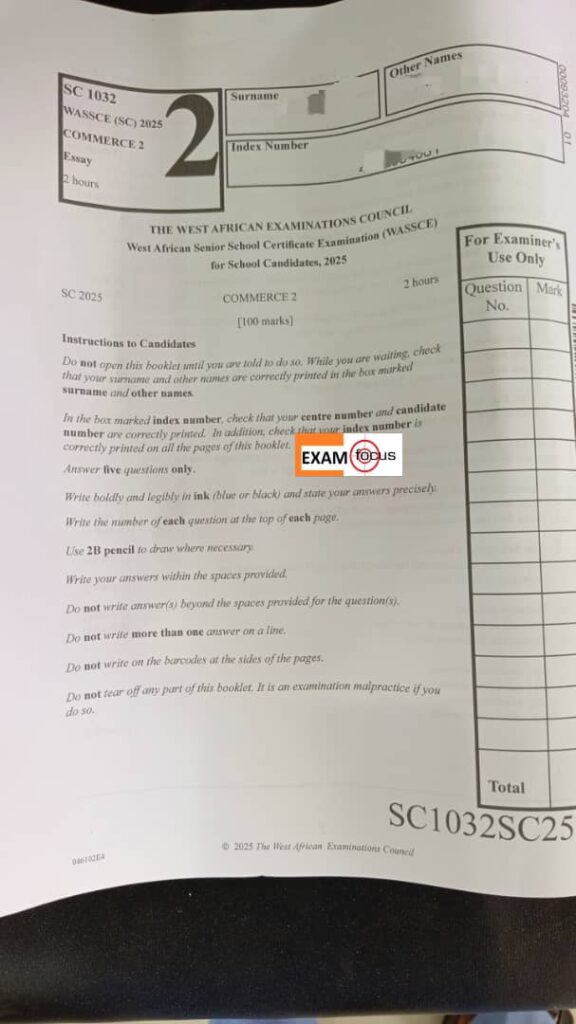
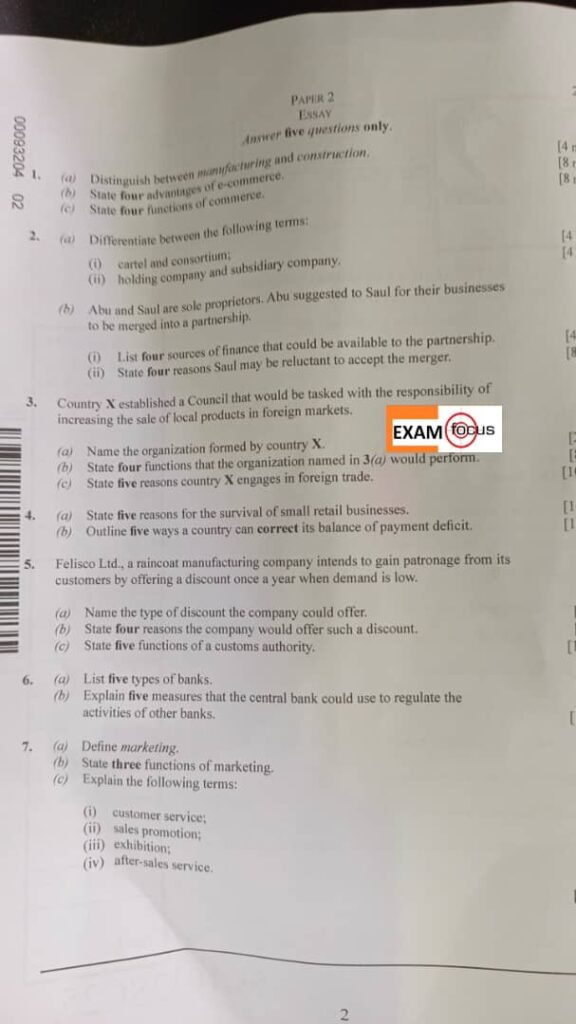

=====================================
WAEC COMMERCE ANSWERS* *NUMBER ONE*
(1a)Manufacturing is the process of producing goods in factories using machines and labor, usually in a controlled, repetitive, and standardized environment. *WHILE* Construction is the process of building structures on-site, often involving unique designs and adapting to site-specific conditions.
(1b)(PICK FOUR ONLY)(i) Global Reach: E-commerce allows businesses to reach customers worldwide, breaking geographical barriers.(ii) 24/7 Availability: Online stores operate around the clock, offering convenience to customers at any time.(iii) Cost Reduction: Lower operating costs compared to physical stores due to reduced need for rent, utilities, and in-store staff.(iv) Faster Transactions: Purchases and payments can be completed quickly online, improving customer satisfaction.(v) Personalized Marketing: Businesses can use customer data to offer personalized recommendations and promotions.(vi) Broader Product Range: Online platforms can display more products than physical stores, without space limitations.(vii) Improved Inventory Management: Automation tools in e-commerce help manage inventory more efficiently.(viii) Easy Access to Customer Feedback: Reviews and ratings provide valuable insights to improve products and services
.(1c)(PICK FOUR ONLY)(i) Exchange of Goods and Services: Facilitates buying and selling activities between producers and consumers.(ii) Transportation: Ensures the movement of goods from producers to markets and consumers.(iii) Warehousing: Provides storage facilities to preserve goods until they are needed for sale.(iv) Banking: Offers financial services such as credit, loans, and payment systems to support trade.(v) Insurance: Protects businesses against risks like theft, damage, or loss of goods.(vi) Advertising: Promotes products and services to inform and attract customers.(vii) Communication: Enables quick and efficient exchange of information in business transactions.(viii) Financing: Provides capital needed for production, transportation, and marketing of goods.
*WAEC COMMERCE ANSWERS* *NUMBER TWO*
(2ai)A cartel is an agreement between competing firms to control prices or limit production, while a consortium is a group of independent companies that collaborate on a specific project or venture without restricting competition.
(2aii) A holding company is a firm that owns a controlling interest in one or more other companies, while a subsidiary company is a company that is controlled and partly or wholly owned by the holding company.
(2bi)(PICK FOUR ONLY)(i) Personal savings(ii) Bank loans(iii) Trade credit(iv) Retained earnings(v) Government grants(vi) Hire purchase(vii) Leasing(viii) Venture capital
(2bii)(PICK FOUR ONLY)(i) Loss of control: Saul may be reluctant to merge due to the fear of losing full control over his business decisions.(ii) Unequal profit sharing: Saul might be concerned that the profit-sharing arrangement in the partnership could be unequal or unfavorable to him.(iii) Risk of conflicts: Saul could fear that differences in management styles or disagreements with Abu may lead to conflicts in the partnership.(iv) Financial uncertainty: The merger may introduce financial risks, and Saul might be uncertain about the financial stability of the new partnership.(v) Liability concerns: Saul may be worried about the joint liability in a partnership, where he could be held personally responsible for debts or legal issues.(vi) Change in business culture: Saul might be concerned that merging with Abu could disrupt the established culture of his business.(vii) Loss of independence: As a sole proprietor, Saul is used to making decisions on his own and may be reluctant to share decision-making authority in a partnership.(viii) Legal and administrative complexities: Saul could be hesitant due to the legal paperwork, tax implications, and administrative changes that would come with forming a partnership.
*WAEC COMMERCE ANSWERS* *NUMBER THREE*
(3a)Trade Promotion Council
(3b)(PICK FOUR ONLY)(i) Market Research: Conducts research to identify potential international markets for local products.(ii) Export Promotion: Organizes campaigns and trade fairs to promote local products abroad.(iii) Advisory Services: Offers guidance and support to local businesses on export procedures and market entry strategies.(iv) Training and Capacity Building: Provides training programs for exporters to enhance their knowledge and skills in international trade.(v) Product Development Support: Assists in improving product quality and packaging to meet international standards.(vi) Trade Negotiations: Engages in trade negotiations to secure favorable terms for local exporters.(vii) Market Linkages: Connects local producers with foreign buyers and distributors.(viii) Policy Advocacy: Advises the government on policies that support export growth and competitiveness.
(3c)(PICK FIVE ONLY)(i) Access to wider markets: To sell local products to a larger international customer base.(ii) Earning foreign exchange: To generate revenue in foreign currencies, which strengthens the national economy.(iii) Access to resources: To obtain raw materials and goods not available locally.(iv) Promotion of specialization: To focus on producing goods in which the country has a comparative advantage.(v) Job creation: To create employment opportunities in export-oriented industries.(vi) Improved standards of living: To provide citizens with access to a wider variety of goods and services.(vii) Technology transfer: To benefit from advanced technologies and innovations from trading partners.(viii) Strengthening international relations: To build diplomatic and economic ties with other countries.
*WAEC COMMERCE ANSWERS*
*NUMBER FIVE*
(5a) Seasonal discounts
(5b) (PICK ANY FOUR)(i) To encourage purchases during periods of low demand.(ii) To maintain steady production and reduce idle time.(iii) To clear out old stock or inventory before the next season.(iv) To improve cash flow during slow business periods.(v) To attract new customers and retain existing ones.(vi) To stay competitive in the market and gain market share.
(5c)(PICK ANY FIVE)(i) To collect import and export duties and taxes.(ii) To enforce laws regulating the import and export of goods.(iii) To prevent the entry of prohibited and dangerous goods.(iv) To facilitate legitimate international trade.(v) To compile trade statistics and monitor trade trends.(vi) To protect local industries by implementing tariffs and trade policies.
*WAEC COMMERCE ANSWERS*
*NUMBER SIX*
(6a) (PICK ANY FIVE)(i) Commercial banks(ii) Central bank(iii) Development banks(iv) Merchant banks(v) Mortgage banks(vi) Microfinance banks(vii) Agricultural banks
(6b)(PICK ANY FIVE)(i) Reserve Requirement Ratio: The central bank mandates the percentage of total deposits that commercial banks must keep as reserves. This controls how much money banks can lend, thus influencing liquidity.(ii) Open Market Operations (OMO): The central bank buys or sells government securities in the open market to control the money supply. Selling securities reduces liquidity, while buying increases it.(iii) Interest Rate Policy (Bank Rate): By raising or lowering the rate at which commercial banks borrow from it, the central bank influences the interest rates charged by commercial banks to their customers.(iv) Licensing and Supervision: The central bank grants licenses to banks and supervises their operations to ensure compliance with regulations and financial soundness.(v) Credit Control: The central bank can impose limits on the amount of credit banks can extend or set guidelines on lending priorities to sectors of the economy.(vi) Moral Suasion: The central bank uses persuasion and appeals to influence banks’ behaviors, such as urging them to reduce lending or improve financial practices, without enforcing formal regulations.
*WAEC COMMERCE ANSWERS*
*NUMBER SEVEN*
(7a)Marketing is the process of identifying, anticipating, and satisfying customer needs and wants profitably.
(7b) (PICK ANY THREE)(i) Market research: Gathering and analyzing information about consumers and market trends.(ii) Product development: Creating products that meet customer needs.(iii) Promotion: Communicating product benefits to customers to encourage purchase.(iv) Pricing: Setting competitive prices that reflect value and market conditions.(v) Distribution: Delivering products to customers through appropriate channels.(vi) Customer relationship management: Building and maintaining strong relationships with customers.
(7ci) Customer service: Customer service refers to the assistance and advice provided by a company to those who buy or use its products or services. It includes answering inquiries, handling complaints, and ensuring customer satisfaction.
(7cii) Sales promotion: Sales promotion involves short-term incentives used to encourage the purchase or sale of a product or service, such as discounts, coupons, contests, and buy-one-get-one-free offers.
(7ciii) Exhibition: An exhibition is a public display where businesses showcase their products or services to potential buyers, partners, or the general public, often used as a marketing tool to attract attention and increase brand awareness.
(7civ) After-sales service: After-sales service is the support provided to customers after they have purchased a product, including installation, training, maintenance, repairs, and warranty services. It helps ensure customer satisfaction and repeat business.
Loading… Keep refreshing!
WAEC Commerce Objective (OBJ) Answers:
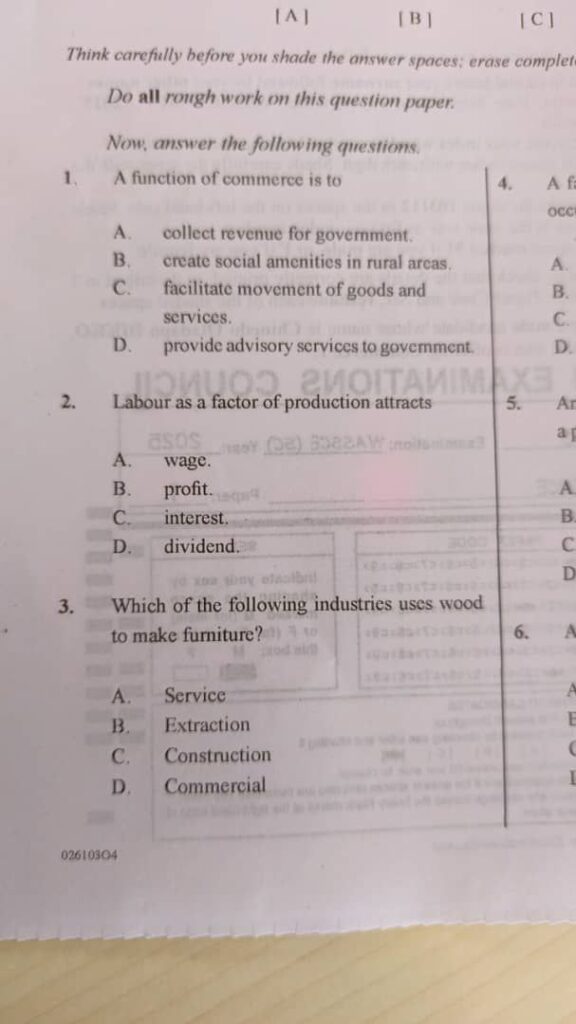
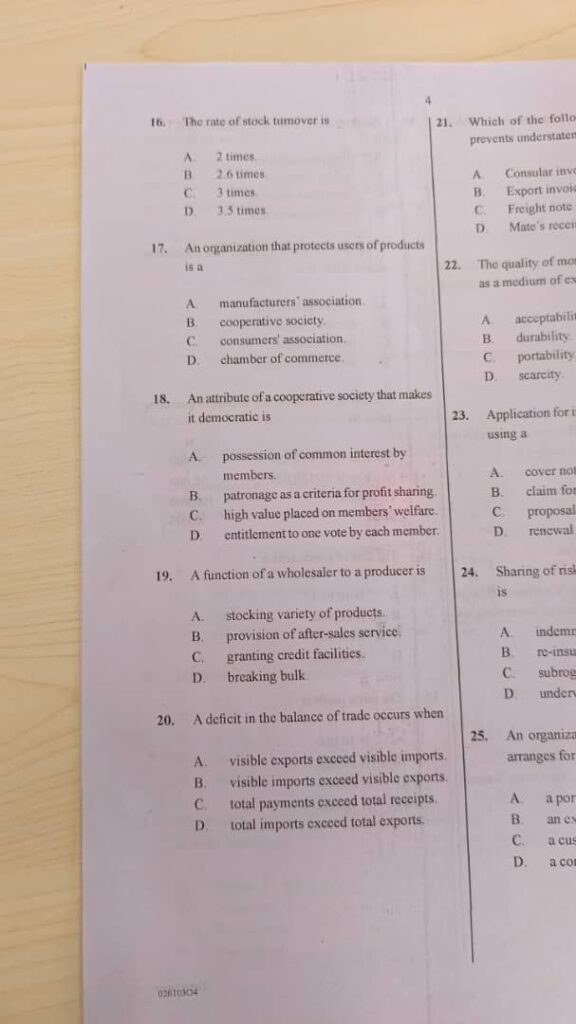

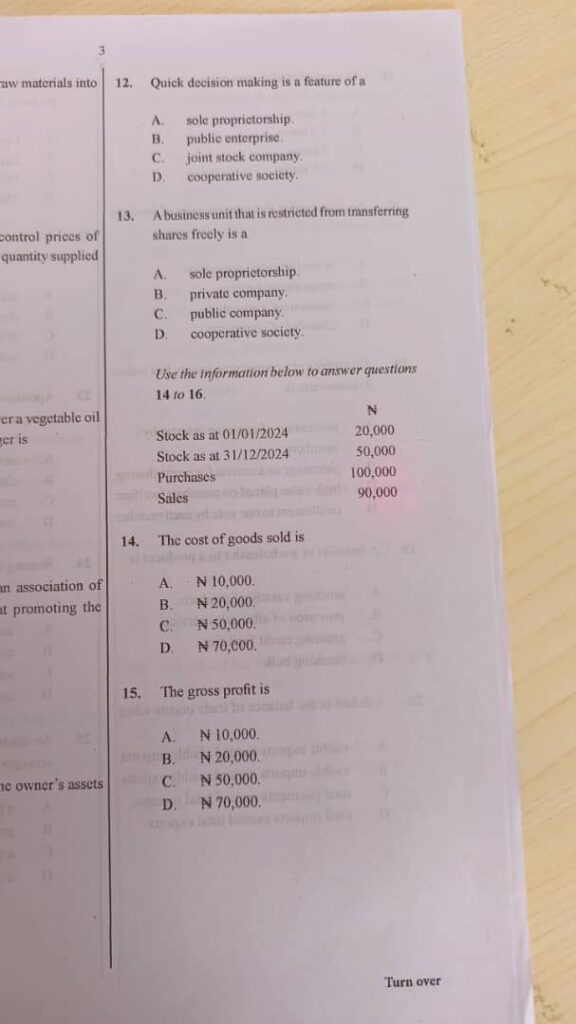
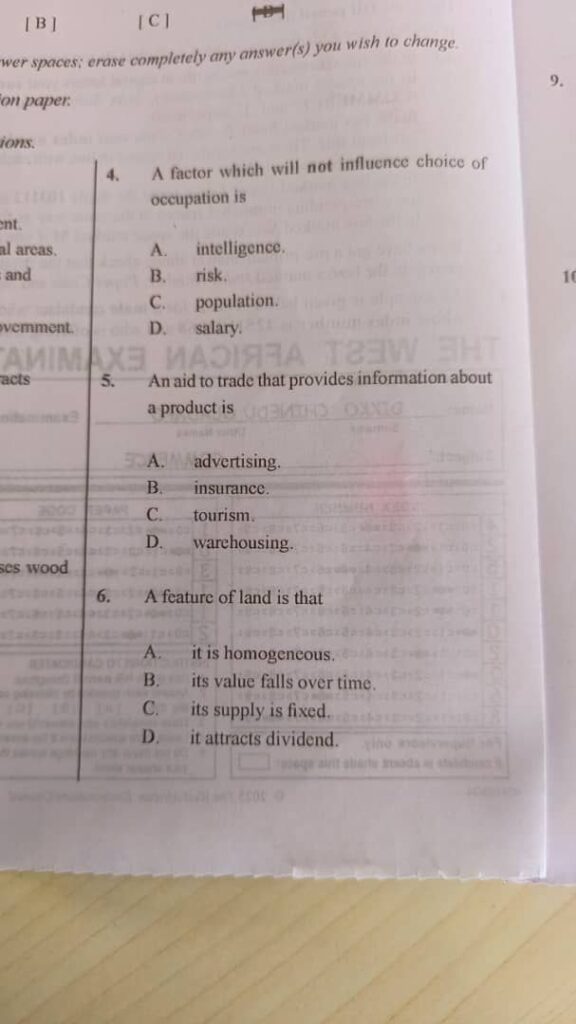
====================================
COMMERCE OBJ
01-10: CBBADBCCCA
11-20: CCBABDABAD
21-30: AACABACCAA
31-40: BCADDADDBA
41-50: DACCDDDABD
COMPLETED
Loading… Keep refreshing!
ALSO READ MORE: EXAM’s Past Questions and Answers


Share Your Opinion!
Comments